Duration: 2 days
Day 1
Zelenograd (~30 km. from Moscow).
- Click Zelenograd
Klin (~60 km. from Zelenograd)
- Click Klin
Yamuga (~8 km. from Klin)
- Click Yamuga
Zavidovo (~18 km. from Yamuga)
- Click Zavidovo
Mokshino (~8 km. from Zavidovo)
- Click Mokshino
Emmaus (~40 km. from Mokshino)
- Click Emmaus
Pominovo (~40 km. from Emmaus)
- Click Pominovo
Tver (~20 km. from Pominovo)
- Click Tver
Torzhok (~60 km. from Tver)
- Click Torzhok
Nilov monastery (~140 km. from Torzhok)
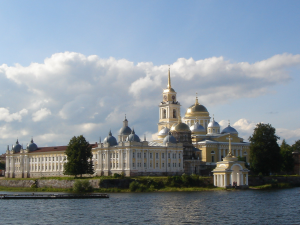 The monastery is located on an island on Lake Seliger, in the northwest of the Valdai Hills, within a picturesque landscape of forests and hills. Lake Seliger is one of the biggest natural lakes of Central Russia.
The monastery is located on an island on Lake Seliger, in the northwest of the Valdai Hills, within a picturesque landscape of forests and hills. Lake Seliger is one of the biggest natural lakes of Central Russia.- The monastery was founded by Saint Nil in 16th century. Nil and Nila are male and female Russian names, but they are universal. For instance, Nila is a female name in India. In Sanskrit Nila means ‘Blue’. That is also true for the distinguish color of the Lake Seliger. The Blue Nile originating at Lake Tana in Ethiopia forms the famous Nile River, regarded as the longest river in the world. In Ethiopia the upper course of the Blue Nile is regarded as holy and identified as one of four rivers issuing out of the Garden of Eden. New Year’s Day in the Ethiopian Orthodox Calendars is September 11.
- Nilov Monastery was one of the largest and wealthiest monasteries in the Russian Empire. Today the monastery complex remains one of the most impressive ensembles of Neoclassical architecture in Eastern Europe.
- Nearby Gorodomlya Island (former strict order skete or hermitage of Nilov monastery) was the secretive place, where after the World War II, top German rocket scientists and engineers (from Wernher von Braun’s team) worked together with Russian scientists on the Soviet space program. There is a saying that Russia’s staircase to Cosmos started here.
Night in Nilov monastery
Day 2
The source of the Volga River (~95 km. from Nilov monastery)
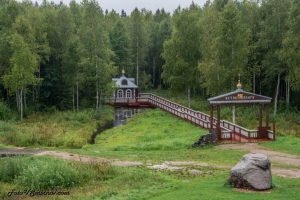 The Volga River (~3 700 km.) is the longest river in Europe. It starts in Tver region and flows through central Russia into the Caspian Sea.
The Volga River (~3 700 km.) is the longest river in Europe. It starts in Tver region and flows through central Russia into the Caspian Sea.- The Tver region still has many Sanskrit names, including Deli that is the capital of today’s India. Many rivers in the Volga basin, including its major tributaries have names understood from Sanskrit: Kama, Oka, Sura, etc.
- In Sanskrit, the word ‘Valga’ (that is quite close to ‘Volga’) has several meanings, including ‘veils’ or ‘artery’, ‘one who veils or covers’, etc. Indeed, Volga is Europe’s largest river in terms of discharge and watershed.
- Mother Volga is the national symbol of Russia. Its vast territories were the cradle of the Indo-Europeans. Today, the Indo-European language family is more than 3,4 billion speakers worldwide or about half of the human population. 11 of the 20 largest Russian cities, including Moscow, are located in the Volga’s watershed.
- The Volga starts in Valdai Hills (the Tver region). Some researches compare the Valdai Hills to the legendary Mount Meru from Mahabharata (major Sanskrit epic of ancient India) and the mountain Hara from the ancient Iranian book Avesta. According to the Avesta, the rivers Ra, Rusija, Ardvi-Sura run down the Hara. The Volga’s ancient (or the Scythian) name was Ra. Many cities located on the Volga still bear this root. For instance, Samara, Saratov, Astrakhan, etc.
- The Valdai is a place of many lakes and the origin of the largest European rivers: the Volga (~3700 km.), the Dnieper (2 145 km.), the Desna (1130 km.), the Western Dvina (1020 km.), etc.
- The Valdai Hills (>600 km.) is the natural watershed of three seas: the Caspian Sea (the Volga), the Black Sea (the Dnieper) and the Baltic Sea (the Western Dvina, etc.). This ridge stretches in the latitudinal direction ‘from sunset to sunrise’, i.e. ‘from west to east’. It is important. Interestingly, the Avesta and the Rig Veda as well as ancient historians constantly repeated that the sacred Hara, Meru and the Riphean mountains stretched from west to east.
- The Volga provides more than 60% of drinking and industrial water for the Russian capital. The Moscow Canal (connecting the Moskva River with the Volga River) provides Moscow access to five seas: the White Sea, Baltic Sea, Caspian Sea, Sea of Azov, and the Black Sea. This is why Moscow is sometimes called the «port of the five seas».
- Fascinating is the global history of Rybinsk which got in 1953 the monument “Mother Volga”.
Okovets Holy Spring (~140 km. from the source of the Volga)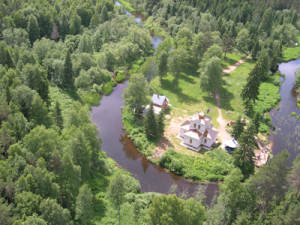
- The source is in the bend of local river Pyroshnya.
- According to legend, this place was opened to people in the 16th century, when an icon of the Cross of the Lord and later an icon of the Mother of God appeared here in the dense forest.
- The Russian Tsar Ivan the Terrible funded building two churches in this place.
Staritsa (~120 km. from the Okovets Holy Spring)
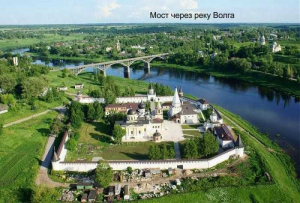 This town is located on the both banks of the Volga River. Its known history starts from 13th century.
This town is located on the both banks of the Volga River. Its known history starts from 13th century.- Staritsa was a beloved place of the above mentioned Ivan the Terrible (1530 – 1584), the most famous Russian ruler and the first Russian tsar (king) crowned as the Byzantine emperors.
- Staritsa use to have a cathedral similar to the famous St. Basil’s Cathedral in Moscow.
- The first Russian Orthodox Church’s Patriarch was born in Staritsa in 16th century.
- Staritsa is also noted among speleologists for its 18th–19th century quarries. The longest quarries have a total length of passages up to 5 km.
Josef of Volokolamsk monastery (100 km. from Staritsa)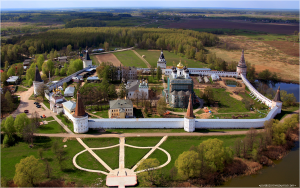
- The monastery was founded in 1479 by st. Joseph of Volokolamsk. It soon became the most authoritative and wealthy monastery in Russia.
- Joseph of Volokolamsk was a prominent Russian theologian who led the party defending monastic land ownership.
Savvino-Storozhevsky monastery (~90 km. from Josef of Volokolamsk monastery)
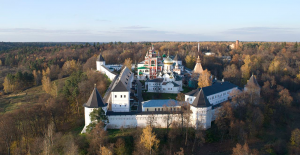 The monastery was founded in the 14th century by St. Savva of Storozhi.
The monastery was founded in the 14th century by St. Savva of Storozhi.- In the 15-17 centuries the monastery was an outpost of the Moscow principality in the west.
- The monastery was a favorite place of prayer for many Russian Tsars. In 17th century, it became a suburban residence of the Russian Tsar and his family. The monastery was surrounded by stone walls, the royal chambers were built. The temples of the monastery were decorated by icon painters of the Armory Chamber of the Moscow Kremlin.
- A special Zvenigorodsky tract, which was also known as the Royal Route or the Road of the Kings of the God-chosen, was laid from Moscow to the monastery. Russian rulers made pilgrimages to the Savino-Storozhevsky Monastery by this road.
- This picturesque area was always the favorite place for the royal falcon hunting and for homes of the Russian nobility. The times changed, but the ‘nobility’ continued to live. In the mid-1990s, the area along the former Royal Route, was turned into a kind of a ‘millionaires’ ghetto’, or a Russian Beverly Hills. Also known as Rublyovka, it is a prestigious residential area in the western suburbs of Moscow. Many Russian government officials and successful business people reside along this road in the gated communities. Real-estate prices there are among the highest in the world.
Odintsovo (~40 km. from Savvino-Storozhevsky monastery)
- Click Odintsovo
Night in Moscow
